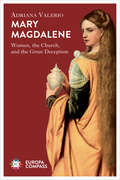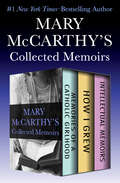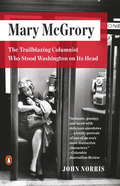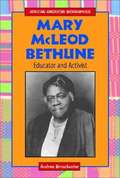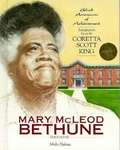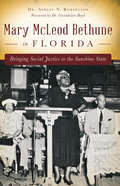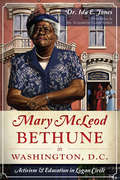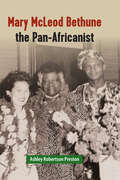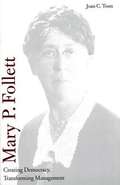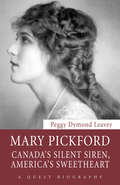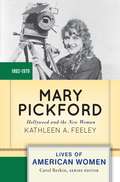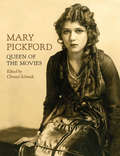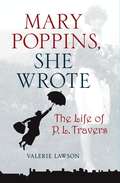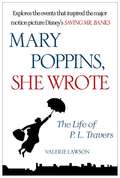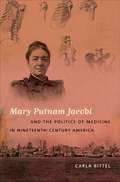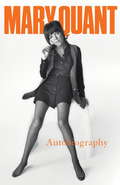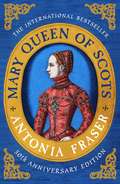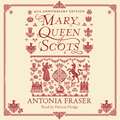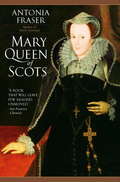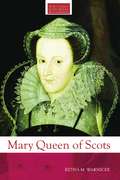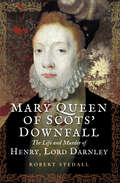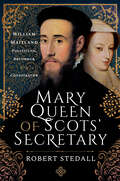- Table View
- List View
Mary Magdalene: Women, the Church, and the Great Deception
by Adriana Valerio“Brilliant . . . Essential reading for anyone who cares about Church history and gender equality. . . . speaks to our times with impressive relevance.” —Reading in TranslationFrom one of Italy’s most renowned historians of religion, an exciting new portrait of one of Christianity’s most complex—and most misunderstood—figures: Mary MagdaleneJesus’ favorite and most devoted disciple? A prostitute shunned from her community? A symbol of female leadership and independence? Who really was Mary Magdalene, and how does her story fit within the history of Christianity, and that of female emancipation?In this meticulously researched, highly engaging book, Adriana Valerio looks at history, art, and literature to show how centuries of misinterpretation and willful distortion—aimed at establishing and preserving gender hierarchies—have stripped this historical figure of her complexity and relevance.By revealing both the benign and the pernicious misrepresentations of Mary Magdalene, this thought-provoking essay reaffirms the central role played by women in the origins of Christianity and their essential contribution to one of the founding experiences of Western thought and society.“Persuasive. . . . Academics working in Christianity should get much from this well-argued study.” —Publishers Weekly“A masterful work.” —Osservatore Romano“A short and readable yet sweeping and well-researched essay that stands out for its intellectual honesty [ . . . ] We are all Mary Magdalene.” —Cultura al femminile
Mary McCarthy's Collected Memoirs: Memories of a Catholic Girlhood, How I Grew, and Intellectual Memoirs
by Mary McCarthyThree candid, affecting memoirs by the #1 New York Times–bestselling author of The Group, including a National Book Award finalist. In Memories of a Catholic Girlhood, Mary McCarthy begins with her recollections of a happy childhood cut tragically short by the death of her parents during the influenza epidemic of 1918. Tempering memory with invention, McCarthy describes how, orphaned at six, she spent much of her childhood shuttled between two sets of grandparents and three religions—Catholic, Protestant, and Jewish. Early on, McCarthy lets the reader in on her secret: The chapter you just read may not be wholly reliable—facts have been distilled through the hazy lens of time and distance.How I Grew is McCarthy&’s intensely personal autobiography of her life from age thirteen to twenty-one. With detail driven by an almost astonishing memory recall, the author gives us a masterful account of these formative years. From her wild adolescence—including losing her virginity at fourteen—through her eventual escape to Vassar, the bestselling novelist, essayist, and critic chronicles her relationships with family, friends, lovers, and the teachers who would influence her writing career. And Intellectual Memoirs opens with McCarthy as a married twenty-four-year-old Communist and critic. She&’s disciplined, dedicated, and sexually experimental: At one point she realizes that in twenty-four hours she &“had slept with three different men.&” Over the course of three years, she will have had two husbands, the second being the esteemed, much older critic Edmund Wilson. It is Wilson who becomes McCarthy&’s mentor and muse, urging her to try her hand at fiction. Intellectual Memoirs is a vivid snapshot of a distinctive place and time—New York in the late 1930s—and the forces that shaped Mary McCarthy&’s life as a woman and a writer.
Mary McGrory
by John NorrisA wildly entertaining biography of the trailblazing Washington columnist and the first woman to win the Pulitzer Prize for commentary Before there was Maureen Dowd or Gail Collins or Molly Ivins, there was Mary McGrory. She was a trailblazing columnist who achieved national syndication and reported from the front lines of American politics for five decades. From her first assignment reporting on the Army-McCarthy hearings to her Pulitzer-winning coverage of Watergate and controversial observations of President Bush after September 11, McGrory humanized the players on the great national stage while establishing herself as a uniquely influential voice. Behind the scenes she flirted, drank, cajoled, and jousted with the most important figures in American life, breaking all the rules in the journalism textbook. Her writing was admired and feared by such notables as Lyndon Johnson (who also tried to seduce her) and her friend Bobby Kennedy who observed, "Mary is so gentle--until she gets behind a typewriter." Her soirees, filled with Supreme Court justices, senators, interns, and copy boys alike, were legendary. As the red-hot center of the Beltway in a time when the newsrooms were dominated by men, McGrory makes for a powerfully engrossing subject. Laced with juicy gossip and McGrory's own acerbic wit, John Norris's colorful biography reads like an insider's view of latter-day American history--and one of its most enduring characters.
Mary McLeod Bethune
by Andrea BroadwaterTraces the life and achievements of the black educator who fought bigotry and sought equality for blacks in the areas of education and political rights. Includes bibliographical references and index.
Mary McLeod Bethune (Black Americans of Achievement--Legacy Edition)
by Malu HalasaTraces the life and achievements of the black educator who fought bigotry and racial injustice and sought equality for blacks in the areas of education and political rights.
Mary McLeod Bethune (Cornerstones of Freedom)
by Patricia C. Mckissack Fredrick L. MckissackTraces the life and advancements of the Bethune who fought bigotry and sought equality for blacks in the areas of education and political rights.
Mary McLeod Bethune in Florida: Bringing Social Justice to the Sunshine State
by Ashley N. RobertsonA vibrant biography of the woman who shaped the political climate of Daytona Beach with her civil rights, women’s rights, and education activism.Mary McLeod Bethune was often called the “First Lady of Negro America,” but she made significant contributions to the political climate of Florida as well. From the founding of the Daytona Literary and Industrial School for Training Negro Girls in 1904, Bethune galvanized African American women for change. She created an environment in Daytona Beach that, despite racial tension throughout the state, allowed Jackie Robinson to begin his journey to integrating Major League Baseball less than two miles away from her school. Today, her legacy lives through a number of institutions, including Bethune-Cookman University and the Mary McLeod Bethune Foundation National Historic Landmark. Historian Ashley Robertson explores the life, leadership and amazing contributions of this dynamic activist.
Mary McLeod Bethune in Washington, D.C.: Activism & Education in Logan Circle
by Dr. Ida E. JonesThe civil rights leader&’s life and work in the nation&’s capital, and her influence around the world, are celebrated in this biography. Best known as an educator and early civil rights activist, Mary McLeod Bethune was the daughter of formerly enslaved people. After moving to Washington, D.C., in 1936, she founded the National Council of Negro Women, an organization that supported Black women through numerous educational and community-based programs. Bethune also led the charge to change the segregationist policies of local hospitals and concert halls, and she acted as a mentor to countless African American women in the District. In this loving biography, historian Ida E. Jones explores the monumental life of Mary McLeod Bethune as a leader, a crusader, and a Washingtonian.
Mary McLeod Bethune the Pan-Africanist
by Ashley Robertson PrestonHighlighting Bethune’s global activism and her connections throughout the African diaspora This book examines the Pan-Africanism of Mary McLeod Bethune through her work, which internationalized the scope of Black women’s organizations to create solidarity among Africans throughout the diaspora. Broadening the familiar view of Bethune as an advocate for racial and gender equality within the United States, Ashley Preston argues that Bethune consistently sought to unify African descendants around the world with her writings, through travel, and as an advisor.Preston shows how Bethune’s early involvement with Black women’s organizations created personal connections across Cuba, Haiti, India, and Africa and shaped her global vision. Bethune founded and led the National Council of Negro Women, which strengthened coalitions with women across the diaspora to address issues in their local communities. Bethune served as director of the Division of Negro Affairs for the Franklin D. Roosevelt administration and later as associate consultant for the United Nations alongside W.E.B. DuBois and Walter White, using her influence to address diversity in the military, decolonization, suffrage, and imperialism. Mary McLeod Bethune the Pan-Africanist provides a fuller, more accurate understanding of Bethune’s work, illustrating the perspective and activism behind Bethune’s much-quoted words: “For I am my mother’s daughter, and the drums of Africa still beat in my heart.” Publication of this work made possible by a Sustaining the Humanities through the American Rescue Plan grant from the National Endowment for the Humanities.
Mary P. Follett: Creating Democracy, Transforming Management
by Joan C. TonnMary P. Follett (1868-1933) brought new dimensions to the theory and practice of management and was one of America's preeminent thinkers about democracy and social organization. The ideas Follett developed in the early twentieth century continue even today to challenge thinking about business and civic concerns. This book, the first biography of Follett, illuminates the life of this intriguing woman and reveals how she devised her farsighted theories about the organization of human relations. --BOOK JACKET. Title Summary field provided by Blackwell North America, Inc. All Rights Reserved
Mary Pickford: Canada’s Silent Siren, America’s Sweetheart
by Peggy Dymond LeaveyMary Pickford’s ambition, passion, innate talent, and savvy business acumen sent her career into the stratosphere and set the blueprint for the modern movie star. Born Gladys Louise Smith in 1892, Pickford was raised in a house on University Avenue in Toronto and began her acting career on the stage. However, her determination led her to the new world of motion pictures, where she not only revolutionized acting method but negotiated her own terms for the highest salary for any actress and complete creative control over her films – unheard of behaviour for a woman of that period. Pickford co-founded United Artists in 1919 with Douglas Fairbanks and Charlie Chaplin, which turned the existing studio system on its head. The actress’s subsequent marriage to Fairbanks incited a fan frenzy comparable to today’s obsession with couples like Brad Pitt and Angelina Jolie. Although Pickford’s star faded with the advent of talking pictures, she was the catalyst for the culture of Hollywood celebrity that enthralls us today.
Mary Pickford: Hollywood And The New Woman
by Kathleen A. FeeleyOn screen and off, movie star Mary Pickford personified the "New Woman" of the early 1900s--a moniker given to women who began to demand more autonomy inside and outside the home. Well educated and career-minded, these women also embraced the new mass culture in which consumption and leisure were seen to play a pivotal role in securing happiness. Mary Pickford: Hollywood and the New Woman examines Pickford's role in the rise of industrial capitalism and consumer culture, and uses her life and unprecedented career as a wildly popular actress and savvy film mogul to illustrate the opportunities and obstacles faced by American women during this time. Following Pickford's life from her childhood on stage to her rise as a powerful studio executive, this book gives an overview of her enduring contribution to American film and mass culture. It also explores her struggles to surpass her confining public film persona as "America's Sweetheart" with her creative and business achievements--mirroring how women, both then and today, must reconcile domestic life with professional aspirations and work. About the Lives of American Women series: Selected and edited by renowned women's historian Carol Berkin, these brief biographies are designed for use in undergraduate courses. Rather than a comprehensive approach, each biography focuses instead on a particular aspect of a women's life that is emblematic of her time, or which made her a pivotal figure in the era. The emphasis is on a "good read," featuring accessible writing and compelling narratives, without sacrificing sound scholarship and academic integrity. Primary sources at the end of each biography reveal the subject's perspective in her own words. Study questions and an annotated bibliography support the student reader.
Mary Pickford: Queen of the Movies
by Christel Schmidt&“Explains Pickford&’s roles as not only a talented actress, but also as a philanthropist and industry leader who managed to end up her own producer.&” —Time Out In the early days of cinema, when actors were unbilled and unmentioned in credits, audiences immediately noticed Mary Pickford. Moviegoers everywhere were riveted by her magnetic talent and appeal as she rose to become cinema&’s first great star. In this engaging collection, co-published with the Library of Congress, an eminent group of film historians sheds new light on this icon&’s incredible life and legacy. Pickford emerges from the pages in vivid detail, revealed as a gifted actress, a philanthropist, and a savvy industry leader who fought for creative control of her films and ultimately became her own producer. With extensive photos and illustrations, this book paints a fascinating portrait of a key figure in American cinematic history. Includes over 200 photos, illustrations, and stills from the collections of the Library of Congress and Academy of Motion Picture Arts and Sciences
Mary Poppins, She Wrote
by Valerie LawsonThe remarkable life of P.L. Travers, the creator of Mary Poppins.An arresting life...Lawson is superb at excavating the details. -Library Journal The spellbinding stories of Mary Poppins, the quintessentially English and utterly magical nanny, have been loved by generations. She flew into the lives of the unsuspecting Banks family in a children's book that was instantly hailed as a classic, then became a household name when Julie Andrews stepped into the title role in Walt Disney's hugely successful and equally classic film. But the Mary Poppins in the stories was not the cheery film character. She was tart and sharp, plain and vain. She was a remarkable character. The story of Mary Poppins' creator, as this definitive biography reveals, is equally remarkable. The fabulous English nanny was actually conceived by an Australian, Pamela Lyndon Travers, who came to London in 1924 from Queensland as a journalist. She became involved with Theosophy, traveled in the literary circles of W.B. Yeats and T.S. Eliot, and became a disciple of the famed spiritual guru, Gurdjieff. She famously clashed with Walt Disney over the adaptation of the Mary Poppins books into film. Travers, whom Disney accused of vanity for "thinking you know more about Mary Poppins than I do," was as tart and opinionated as Julie Andrews's big-screen Mary Poppins was cheery. Yet it was a love of mysticism and magic that shaped Travers's life as well as the character of Mary Poppins. The clipped, strict, and ultimately mysterious nanny who emerged from her pen was the creation of someone who remained inscrutable and enigmatic to the end of her ninety-six years. Valerie Lawson's illuminating biography provides the first full look whose personal journey is as intriguing as her beloved characters.
Mary Poppins, She Wrote: The Life of P. L. Travers
by Valerie LawsonTHE ONLY TRUE STORY BEHIND THE CREATOR OF MARY POPPINS The remarkable life of P.L. Travers, the creator of Mary Poppins—perfect for fans of the movie Mary Poppins Returns and the original Disney classic! &“An arresting life…Lawson is superb at excavating the details.&” —Library JournalThe spellbinding stories of Mary Poppins, the quintessentially English and utterly magical nanny, have been loved by generations. She flew into the lives of the unsuspecting Banks family in a children&’s book that was instantly hailed as a classic, then became a household name when Julie Andrews stepped into the title role in Walt Disney&’s hugely successful and equally classic film. But the Mary Poppins in the stories was not the cheery film character. She was tart and sharp, plain and vain. She was a remarkable character. The story of Mary Poppins&’ creator, as this definitive biography reveals, is equally remarkable. The fabulous English nanny was actually conceived by an Australian, Pamela Lyndon Travers, who came to London in 1924 from Queensland as a journalist. She became involved with Theosophy, traveled in the literary circles of W.B. Yeats and T.S. Eliot, and became a disciple of the famed spiritual guru, Gurdjieff. She famously clashed with Walt Disney over the adaptation of the Mary Poppins books into film. Travers, whom Disney accused of vanity for &“thinking you know more about Mary Poppins than I do,&” was as tart and opinionated as Julie Andrews&’s big-screen Mary Poppins was cheery. Yet it was a love of mysticism and magic that shaped Travers&’s life as well as the character of Mary Poppins. The clipped, strict, and ultimately mysterious nanny who emerged from her pen was the creation of someone who remained inscrutable and enigmatic to the end of her ninety-six years. Valerie Lawson&’s illuminating biography provides the first full look whose personal journey is as intriguing as her beloved characters.
Mary Putnam Jacobi and the Politics of Medicine in Nineteenth-Century America
by Carla BittelIn the late nineteenth century, as Americans debated the "woman question," a battle over the meaning of biology arose in the medical profession. Some medical men claimed that women were naturally weak, that education would make them physically ill, and that women physicians endangered the profession. Mary Putnam Jacobi (1842-1906), a physician from New York, worked to prove them wrong and argued that social restrictions, not biology, threatened female health. Mary Putnam Jacobi and the Politics of Medicine in Nineteenth-Century America is the first full-length biography of Mary Putnam Jacobi, the most significant woman physician of her era and an outspoken advocate for women's rights. Jacobi rose to national prominence in the 1870s and went on to practice medicine, teach, and conduct research for over three decades. She campaigned for co-education, professional opportunities, labor reform, and suffrage--the most important women's rights issues of her day. Downplaying gender differences, she used the laboratory to prove that women were biologically capable of working, learning, and voting. Science, she believed, held the key to promoting and producing gender equality. Carla Bittel's biography of Jacobi offers a piercing view of the role of science in nineteenth-century women's rights movements and provides historical perspective on continuing debates about gender and science today.
Mary Quant: My Autobiography
by Mary QuantMary Quant defined the 60s as a renowned fashion designer and all-round style icon, most famous for inventing the miniskirt and hot pants. Not afraid of novelty or experimentation, she showed a generation of women how to dress to please themselves. Quant's career was fulsome and varied - from opening up a clothes shop on the King's Road called Bazaar, designing the interior of the Mini (including her signature daisy), to her vast cosmetics company, Mary Quant Limited, she has widespread appeal to generations of women. In her autobiography, Mary combines the inspirational story of a stellar career with the touching personal story of her life with the man she loved, Alexander Plunkett-Green and her role of mother to their son, Orlando. Mary Quant gives us a glimpse of the real women behind the icon.
Mary Quant: My Autobiography
by Mary QuantMary Quant defined the 60s as a renowned fashion designer and all-round style icon, most famous for inventing the miniskirt and hot pants. Not afraid of novelty or experimentation, she showed a generation of women how to dress to please themselves. Quant's career was fulsome and varied - from opening up a clothes shop on the King's Road called Bazaar, designing the interior of the Mini (including her signature daisy), to her vast cosmetics company, Mary Quant Limited, she has widespread appeal to generations of women. In her autobiography, Mary combines the inspirational story of a stellar career with the touching personal story of her life with the man she loved, Alexander Plunkett-Green and her role of mother to their son, Orlando. Mary Quant gives us a glimpse of the real women behind the icon.
Mary Queen Of Scots
by Antonia Fraser'Ground-breaking ... One of the greatest international bestsellers of the post-war period' Andrew Roberts, Daily Telegraph'Reads like an engrossing novel' Sunday TimesAn infant queen. A teenage widow. Beautiful, flamboyant Mary Queen of Scots had a formidable intellect but her political sense - formed at the absolute court of France - plunged her country into a maelstrom of intrigue, marriage and murder. Upon fleeing to England she was held captive by her cousin Elizabeth I. In this classic biography, reissued for the fiftieth anniversary of its publication, acclaimed historian Antonia Fraser relates the enthralling story of Mary's life and untimely end.
Mary Queen Of Scots
by Lady Antonia FraserMary Queen of Scots passed her childhood in France and married the Dauphin to become Queen of France at the age of sixteen. Widowed less than two years later, she returned to Scotland as Queen after an absence of thirteen years.Her life then entered its best known phase: the early struggles with John Knox, and the unruly Scottish nobility; the fatal marriage to Darnley and his mysterious death; her marriage to Bothwell, the chief suspect, that led directly to her long English captivity at the hands of Queen Elizabeth; the poignant and extraordinary story of her long imprisonment that ended with the labyrinthine Babington plot to free her, and her execution at the age of forty-four.Read by Patricia Hodge(p) 2002 Orion Publishing Group
Mary Queen of Scots
by Antonia FraserShe was the quintessential queen: statuesque, regal, dazzlingly beautiful. Her royal birth gave her claim to the thrones of two nations; her marriage to the young French dauphin promised to place a third glorious crown on her noble head.<P> Instead, Mary Stuart became the victim of her own impulsive heart, scandalizing her world with a foolish passion that would lead to abduction, rape and even murder. Betrayed by those she most trusted, she would be lured into a deadly game of power, only to lose to her envious and unforgiving cousin, Elizabeth I. Here is her story, a queen who lost a throne for love, a monarch pampered and adored even as she was led to her beheading, the unforgettable woman who became a legend for all time.
Mary Queen of Scots
by Antonia FraserMary Queen of Scots passed her childhood in France and married the Dauphin to become Queen of France at the age of sixteen. Widowed less than two years later, she returned to Scotland as Queen after an absence of thirteen years.
Mary Queen of Scots (Routledge Historical Biographies)
by Retha M. Warnicke"Scholars now have Warnicke to use as their chief one volume study of Mary" Julian Goodare, University of Edinburgh In this biography of one of the most intriguing figures of early modern European history, Retha Warnicke, widely regarded as a leading historian on Tudor queenship, offers a fresh interpretation of the life of Mary Stuart, popularly known as Mary Queen of Scots. Setting Mary's life within the context of the cultural and intellectual climate of the time and bringing to life the realities of being a female monarch in the sixteenth century, Warnicke also examines Mary's three marriages, her constant ill health and her role in numerous plots and conspiracies. Placing Mary within the context of early modern gender relations, Warnicke reveals the challenges that faced her and the forces that worked to destroy her. This highly readable and fascinating study will pour fresh light on the much-debated life of a central figure of the sixteenth century, providing a new interpretation of Mary Stuart's impact on politics, gender and nationhood in the Tudor era.
Mary Queen of Scots' Downfall: The Life and Murder of Henry, Lord Darnley
by Robert StedallThe story of the Scottish ruler—and the mysterious death of her ambitious and controversial husband. In the early hours of February 10, 1567, a large explosion ripped through the lodgings at Kirk o&’ Field, Edinburgh, where Mary Queen of Scotland&’s consort, Henry, Lord Darnley, was staying. Darnley&’s body was found with that of his valet in a neighboring garden the next morning. The queen&’s husband had been murdered—and the ramifications for Mary and Scottish history would be far-reaching. Lord Darnley cuts an infamous figure in Scottish and Tudor history. In life, he proved a controversial character, and his murder at Kirk o&’ Field remains one of British history&’s great unsolved mysteries—the question of whether Mary was implicated has taxed historians ever since. In this engaging and well-researched biography, Robert Stedall reexamines Darnley&’s life and his death. His investigation brings new light and compelling conclusions to a story surrounded by political betrayal, murder, falsified evidence, and conspiracy.
Mary Queen of Scots' Secretary: William Maitland—Politician, Reformer and Conspirator
by Robert Stedall“It’s as good as a Philippa Gregory, and tells you so much more about Mary Queen of Scots and the people with whom she surrounded herself.” —Books MonthlyWilliam Maitland of Lethington was the most able politician and diplomat during the lifetime of Mary Queen of Scots. It was he who masterminded the Scottish Reformation by breaking the ‘Auld Alliance’ with France, which presaged Scotland’s lasting union with England.Although he gained English support to defeat French troops defending Mary’s Scottish throne, he backed her return to Scotland, as the widowed Queen of France. His attempts to gain recognition for her as heir to the English crown were thwarted by her determined adherence to Catholicism.After her remarriage, he spearheaded the plotting to bring down her objectionable husband, Lord Darnley, leading to his murder, after concluding that English and Scottish interests were best served by creating a Protestant regency for their son, Prince James. With encouragement from Cecil in England and the Protestant Lords in Scotland, he concocted evidence to implicate her in her husband’s murder, resulting in her imprisonment and deposition from the Scottish throne.This is the thrilling biography of a complicated man whose loyalty wavered between queen and country and whose behind-the-throne machinations may have caused her undoing—and his own . . . “A modern, convincing—I must also use that popular buzzword ‘game-changing’—biography that combines page-turning narrative with convincing, sophisticated, scholarly argument.” —Steven Veerapen, Professor of History, Strathclyde University
